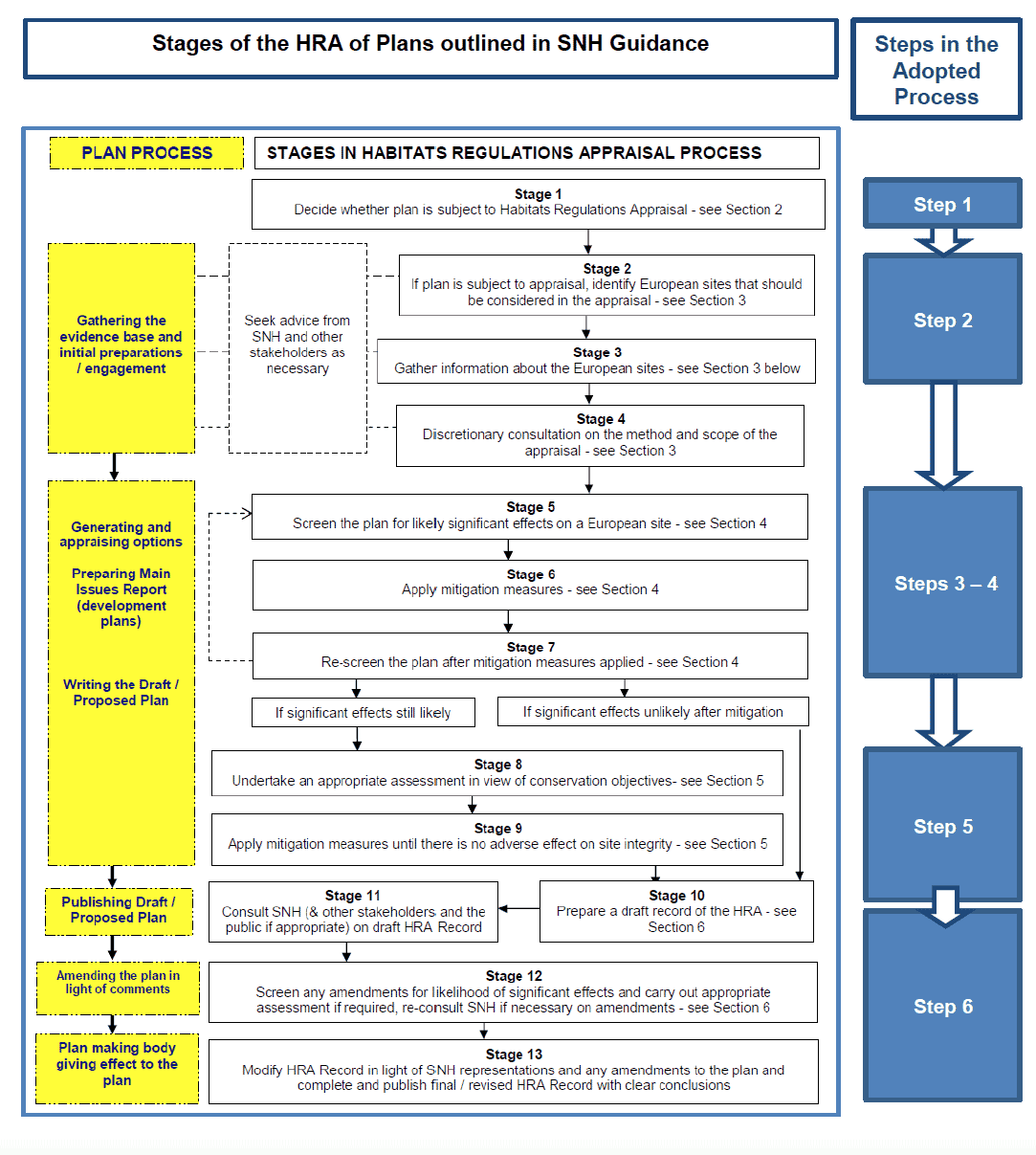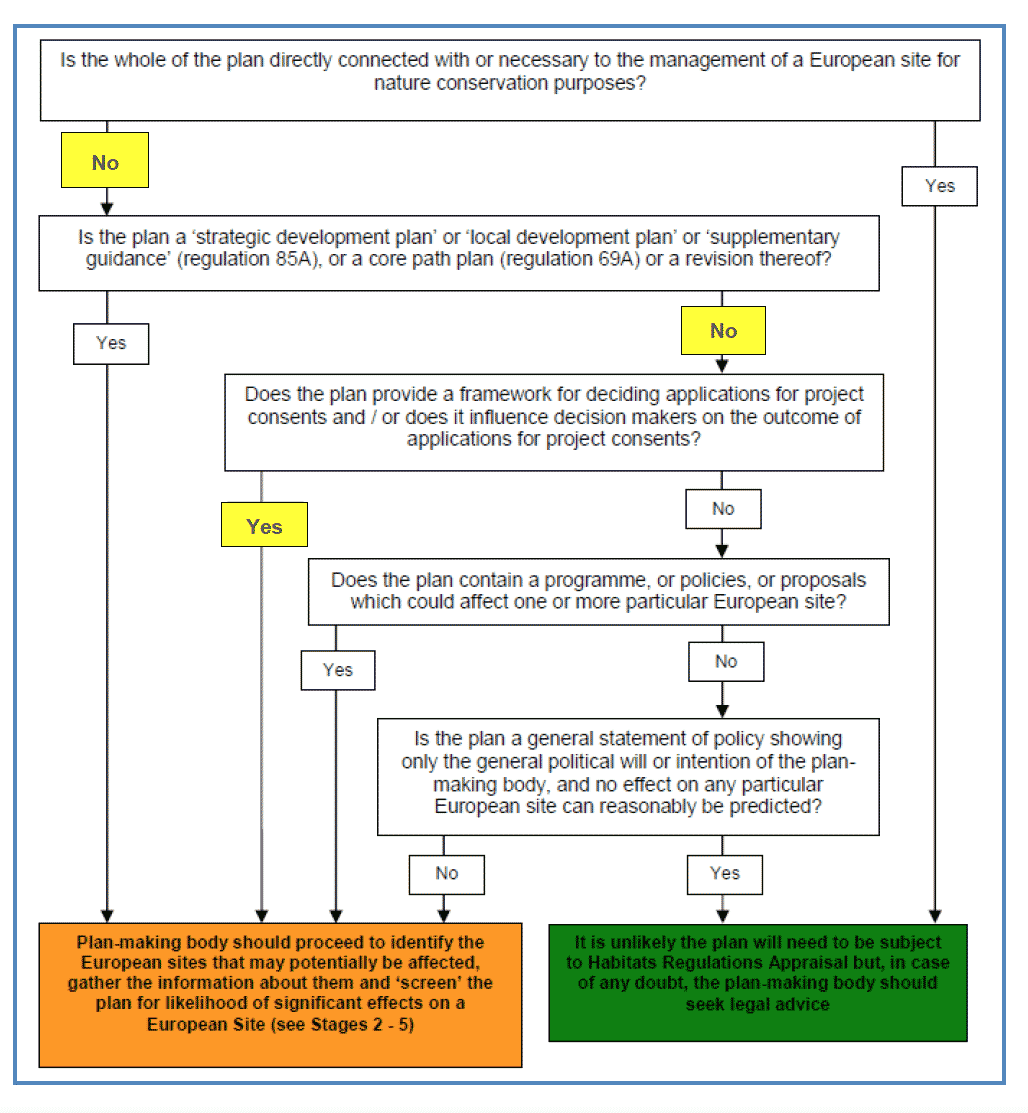Pilot Pentland Firth and Orkney Waters Marine Spatial Plan. Habitats Regulations Appraisal Record.
Habitats Regulations Appraisal Record.
4 Summary of Findings of the HRA Record
Step 1: Decide if a HRA is required
4.1 The initial step of the HRA process involved reviewing the draft Pilot Plan to determine if a HRA was required. This step involved comparing the Plan against criteria set out in Section 2 of the SNH Guidance.
4.2 As shown in Figure 2, this review concluded that while the Pilot Plan would not be directly connected with or necessary to the management of a European site for nature conservation purposes, nor was it identified by regulations 85A or 69A, it would provide a framework for deciding applications and influencing decision-makers as a result of being a material consideration in licencing decisions.
4.3 As a consequence, Marine Scotland considered that the plan should be subject to HRA.
Step 2: Identify European sites
4.4 The second step of the HRA process undertaken involved identifying European sites that should be considered in the screening of the Pilot Plan. This step involved researching the sites and qualifying interests that could be subject to LSE from the Pilot Plan.
4.5 An initial list of sites to be screened was compiled and this is presented in Annex 1 of this Record. At this stage of the process, and given the strategic focus of the Pilot Plan, a review of these sites aided the consideration of potential impact pathways in the next step of the process. However, it was also noted in the Draft Record that, depending on the findings of the screening, a more detailed analysis and appraisal of sites may be required.
Figure 1: The process for undertaking the HRA of the Pilot Plan [7]

Steps 3 - 4: Impact pathways review and identification of activities to which qualifying features are sensitive, and Activity-based screening of European/Ramsar Sites
4.6 The next two steps of the process involved the identification of impact pathways associated with the draft Pilot Plan and the general and sectoral policies contained within it. This work relied heavily on work undertaken on the Strategic Environmental Assessment ( SEA) of the draft Pilot Plan being conducted in parallel to the HRA, and was also informed by previous SEAs and recent or ongoing HRAs undertaken for the Scottish marine environment; notably the Sectoral Marine Plans for Offshore Renewables, the National Marine Plan ( NMP), Marine Protected Areas ( MPAs) [8] , amongst others. For example, these assessments informed the consideration of known pathways and known likely distances for movement of Natura qualifying species.
4.7 From this, the following potential impact pathways were identified:
- Physical loss of habitats from removal or smothering.
- Physical damage to habitats and species from siltation, erosion or physical injury/death.
- Non-physical (indirect) disturbance from noise or visual presence and reduced availability or displacement of species, including prey.
- Toxic contamination from the introduction of synthetic compounds or non-synthetic contaminants.
- Non-toxic contamination from nutrient enrichment, organic enrichment, changes in suspended sediment and turbidity, changes in salinity or changes to the thermal regime.
- Biological disturbance from introduction of microbial pathogens, the introduction of invasive non-native species and translocation, or from selective extraction of selected species.
4.8 In line with the SNH guidance, the Pilot Plan was required to undergo screening with the purpose to:
"a) Identify all aspects of the plan which would have no effect on a European site, so that they can be eliminated from further consideration in respect of this and other plans;
b) Identify all aspects of the plan which would not be likely to have a significant effect on a European site ( i.e. would have some effect but minor residual), either alone or in combination with other aspects of the same plan or other plans or projects, which therefore do not require 'appropriate assessment'; and
c) Identify those aspects of the plan where it is not possible to rule out the risk of significant effects on a European site, either alone or in combination with other plans or projects. This provides a clear scope for the parts of the plan that will require appropriate assessment." [9]
4.9 After identifying the relevant impact pathways, a review of the activities set out in the Pilot Plan and its general and sectoral policies was undertaken. This involved undertaking a Screening of the Plan and its policies 'alone' as outlined in Appendix C of SNH Guidance [10] . This screening process focused on General Policies 1 - 9 and Sectoral Policies 1 - 10 contained within the Pilot Plan, to consider the potential for effects on European sites from each.
4.10 The findings of the Screening are presented in Table 1 and summarised in Section 5.
Steps 5 - 6: Detailed pathway-feature sensitivity review and assessment of the potential effects on European/Ramsar sites, and Preparation of the HRA Record
4.11 Based upon the outcomes of the public consultation process, the draft Pilot Plan and its policies were reviewed. In many instances, revisions were made to the Plan itself and to its policies, and implications for the HRA was also considered based upon these changes. The HRA process was not completed until the publication of the finalised Pilot Plan. The findings of the Draft HRA Record were regularly reviewed and revised, where necessary, to reflect any subsequent changes in the Pilot Plan and/or its policies. This included a review of the findings of previous steps in the HRA process (Steps 1 - 4) and review of the requirement for undertaking an appropriate assessment.
4.12 This Record presents the findings of the HRA undertaken on the finalised Pilot Plan and its policies (Step 6).
Figure 2: Deciding if a plan should be subject to HRA [11]

Table 1: Screening of the General and Sectoral Policies for the likelihood of a significant effect on European Sites identified in the HRA [12]
| Criteria for screening | Relevant parts of the plan (the Policies) | Reason(s) for inclusion in the respective sections of this table and LSE |
|---|---|---|
| General policy statements (Step 1 in Appendix C of SNH Guidance) | General Policies 7 (Integrating Coastal and Marine Development) 8B (Waste and Marine Litter) |
These policies were considered to be statements of general policy. As such, there will be no LSE on a European site. |
| A general criteria based policy (Step 1 in Appendix C of SNH Guidance) | General Policies 1A (Sustainable Development) 1B (Supporting Sustainable Social and Economic Benefits) 1C (Safeguarding the Marine Ecosystem) 2 (The Wellbeing, Quality of Life and Amenity of Coastal Communities) 3 (Climate Change) 4C (Wider Biodiversity) 5B (Coastal Processes and Flooding) 8A (Noise) |
These policies were considered to be statements of general policy outlining broad criteria. As such, there will be no LSE on a European site. |
| Aspects excluded from the appraisal because they are not proposals generated by this plan (Step 2 in Appendix C of SNH Guidance) | Sectoral Policies 2 (Aquaculture) 4 (Renewable Energy Generation) |
These policies reiterate existing policy and requirements for aquaculture and renewable energy ( i.e. detailed in Local Development Plans ( LDPs) and Supplementary Guidance, Sectoral Marine Plans for Renewable Energy, current consenting processes, etc.) and are not considered to contain proposals generated by the Pilot Plan. As such, there will be no LSE on a European site from these policies. |
| Aspects which protect the natural environment, including biodiversity, or conserve or enhance the natural, built or historic environment (Step 3a in Appendix C of SNH Guidance) | General Policies 4A (Nature Conservation Designations) 4B (Protected Species ) 4D (Landscape and Seascape) 4E (Geodiversity) 5A (Water Environment) 6 (Historic Environment) 9 (Invasive Non-native Species) |
These policies will provide additional safeguards to protect the natural and historic environment. As a consequence, there will be no LSE on a European site from these policies. |
| Aspects which will not lead to development or other change (Step 3b in Appendix C of SNH Guidance) | None | None. |
| Aspects which make provision for change but which could have no conceivable effect on a European site, because there is no link or pathway between them and the qualifying interests, or any effect would be a positive effect, or would not otherwise undermine the conservation objectives for the site (Step 3c in Appendix C of SNH Guidance) | None | None. |
| Aspects which make provision for change but which could have no significant effect on a European site (minor residual effects), because any potential effects would be so restricted that they would not undermine the conservation objectives for the site (Step 3d in Appendix C of SNH Guidance) | None | None. |
| Aspects which are too general so that it is not known where, when or how the aspect of the plan may be implemented, or where any potential effects may occur, or which European sites, if any, may be affected (Step 3e in Appendix C of SNH Guidance) | Sectoral Policies 1 (Commercial Fisheries) 3 (Oil and Gas) 5 (Recreation, Sport, Leisure and Tourism) 6 (Marine Transport) 7 (Ports, Harbours and Dredging) 8 (Pipelines, Electricity and Telecommunications Infrastructure) 9 (Marine Aggregates) 10 (Defence) |
The exact location of new infrastructure and/or activities associated with the sectors described in these policies cannot be determined and cannot be linked with certainty to specific European sites. Therefore, these policies are considered too general to reasonably consider LSE either alone or in combination. However, whilst at this stage, links or pathways between the policy and specific European sites cannot be identified, there is potential for future development in the Pentland Firth and Orkney Waters ( PFOW) area to have LSE when its location is determined. It is therefore recommended that in any further planning or proposals at the project level that identify specific locations, further HRA Screening is undertaken as a minimum. |
| LSE to go forward to AA | None | None |
Contact
There is a problem
Thanks for your feedback